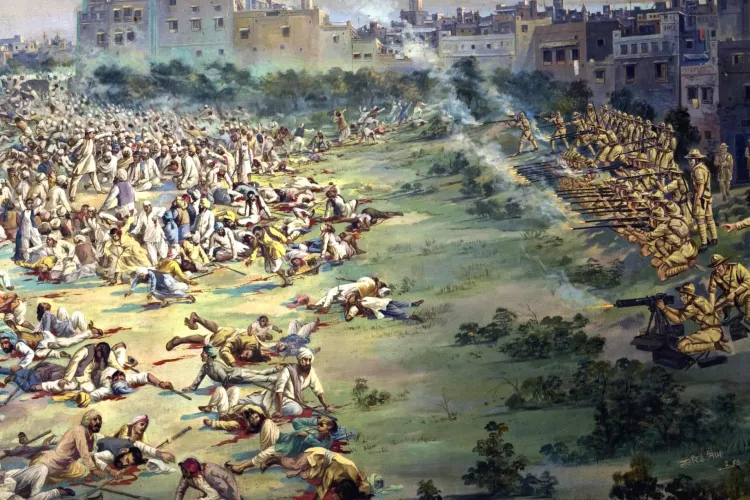Jallianwallah Bagh Massacre Day (1919)
The Jallianwala Bagh massacre marked a turning point in India’s struggle for Independence. A memorial was set up by the Government of India in 1951 at Jallianwala Bagh to commemorate the spirit of Indian revolutionaries and the people who lost their lives in the brutal massacre.
It stands as a symbol of struggle and sacrifice and continues to instill patriotism amongst the youth. In March 2019, the Yaad-e-Jallian Museum was inaugurated showcasing an authentic account of the massacre.
In the year 1919, the Jallianwala Bagh Massacre had occurred on the day of Baishakhi or Vaishaki, a major Punjabi festival, on April 13. Since then, on this day people of India remember the lives of numerous people who died that day and those, who remained alive to recount the horror.
Historical Context:
The backdrop of the massacre was the fervent atmosphere of dissent against British rule that permeated throughout India in the early 20th century. The British Government of India, led by Governor-General Lord Chelmsford and Lieutenant Governor of Punjab Michael O'Dwyer, faced growing opposition from Indian nationalists demanding self-governance and an end to oppressive colonial policies.
In response to the escalating protests, the British authorities imposed martial law in Amritsar, a significant hub of anti-colonial activism. On April 13, 1919, a large crowd had gathered in Jallianwallah Bagh to peacefully protest against the arrest of prominent leaders Dr. Saifuddin Kitchlew and Dr. Satyapal, and to express their grievances against the oppressive Rowlatt Act, which allowed for indefinite detention without trial.
Causes and Timeline of Jallianwala Bagh Massacre 1919

- On 9 April 1919, two local Congress leaders from Amritsar, Dr Saifuddin Kitchlew and Dr Satyapal, who were protesting the atrocity, were detained.
- Banning of Assemblies and Gathering: These arrests occurred at the same time as Gandhi’s, exacerbating the situation in Punjab. The order for the Jallianwala Bagh massacre was given by General Dyer.
- On Baisakhi day, 13 April 1919, a large number of protesters assembled at Jallianwala Bagh to protest.
- Open Fire on Protesters: When Bg. General Reginald Dyer saw a large number of protesters, he ordered the Gurkha forces to open fire on the nonviolent protesters.
- Repression: According to official estimates, 379 people were killed, however, the figure was far too high. The savagery has not yet reached its apex. Punjab was placed under martial law, and repression was stepped up with arrests, torture, and other measures.
- Himalayan blunder: Gandhiji admitted to having committed a Himalayan blunder by offering the weapon of satyagraha to a people insufficiently trained in the discipline of non-violence. Gandhiji was overwhelmed by the atmosphere of total violence and withdrew from the movement on April 18, 1919.
- Knighthood and Hunter Commission: To condemn the massacre, Rabindranath Tagore resigned his knighthood. The British Indian Government created the Hunter Commission to examine the Jallianwala Bagh massacre.
The Massacre:
Under the orders of Brigadier General Reginald Dyer, British troops, primarily consisting of Gurkha and Baluchi soldiers, sealed off the exits of Jallianwallah Bagh and opened fire indiscriminately on the unarmed civilians, who had assembled for a peaceful gathering. The enclosed space of the garden made escape impossible for the thousands trapped within, leading to chaos and unimaginable carnage.
The merciless assault lasted for about ten to fifteen minutes, with soldiers continuously firing until their ammunition was nearly depleted. The exact number of casualties remains disputed, with British estimates stating around 379 fatalities, while Indian sources suggest the death toll was significantly higher, possibly exceeding a thousand, with many more injured.
Aftermath and Impact:
The Jallianwallah Bagh Massacre sent shockwaves across India and the world, igniting outrage and condemnation of British colonial rule. The indiscriminate brutality displayed by the British authorities further galvanized the Indian independence movement, fueling the resolve of nationalists like Mahatma Gandhi and Jawaharlal Nehru to intensify their struggle for freedom through nonviolent means.
The massacre also exposed the ruthlessness of British imperialism and its disregard for the lives and aspirations of the Indian people, sparking widespread revulsion and condemnation internationally. The infamous event led to a significant loss of trust in British governance among Indians and hastened the decline of British colonial influence in India.
Legacy and Commemoration:
The Jallianwallah Bagh Massacre remains etched in the collective memory of India as a somber reminder of the sacrifices made by countless individuals in the pursuit of freedom and justice. The site of the massacre, now transformed into a memorial, stands as a poignant symbol of resilience and remembrance, attracting visitors from around the world to pay homage to the martyrs who lost their lives on that fateful day.
Every year, on April 13, the nation observes Jallianwallah Bagh Massacre Day, commemorating the victims and reaffirming the commitment to upholding the values of freedom, democracy, and human dignity. The event serves as a solemn occasion for reflection on the atrocities of the past and a call to vigilance against any form of oppression or injustice in the present.
Read Also: National Maritime Day 2024: History, Significance and Celebration
In conclusion, the Jallianwallah Bagh Massacre remains a dark chapter in India's history, underscoring the brutal realities of colonial rule and the resilience of those who dared to challenge it. As we honor the memory of the martyrs, let us also renew our pledge to uphold the ideals for which they sacrificed their lives, ensuring that their legacy inspires future generations in the ongoing quest for a more just and equitable society.





